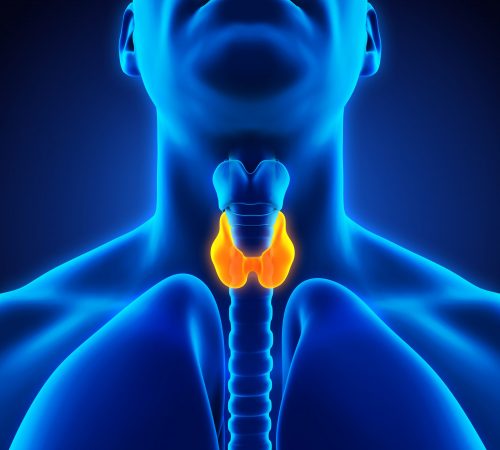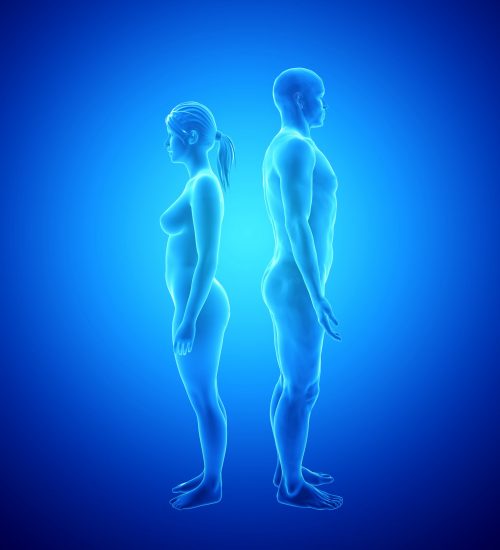Prolactin – Man’s Friend or Foe?

Prolactin is a hormone that is well known for its role in promoting breast milk production. This is particularly true for females, where we see large spikes during pregnancy, especially during the third trimester. This is for obvious reason, such as enabling breast feeding for the mother’s newly born child. While this is the primary function of prolactin, it does also contribute to hundreds of other physiological functions 1–2. Still, this blog is focusing on the relationship of prolactin with males. Males generally have lower serum concentrations of prolactin versus females. Many men also like to give prolactin a bad reputation. So, what role does prolactin play in the normal male physiology?
You may be surprised to hear that it could contribute to a fair few things. One of these is the likely enhancement of luteinizing hormone(LH) receptors (LHR) in the Leydig cells of the testes. This results in increased testosterone secretion when LH binds to LHRs in the Leydig cells, thus promoting spermatogenesis 3. Yes, this is important for those of you who still have testes and are on TRT, as you should be on HCG too.
Prolactin may also have beneficial neuroprotective effects on the central nervous system 4, promote neurogenesis (forming new neurones), and have anti-stress and anxiolytic (anxiety reducing) effects 5. Bear in mind though that these benefits are when prolactin is in a physiologically normal range. The hormone may also play a role in preparing men for parental behaviour; increasing the desire to comfort their children 6.
Much to the best efforts of the underground bodybuilding community, it is not too wise to attempt to push prolactin to near 0 levels. But, as ancient Chinese philosophy taught us, the concept of dualism is often present in many situations. This could be described as a constant fight between states to achieve a balance of ‘Yin and Yang’. This is particularly true in the body, where constant changes occur to meet our homeostatic ‘normal’ state. This is something that is often quite rightly talked about by Dr Robert Stevens. Too much of a good thing can become bad, just as too little can also be bad.
Too much prolactin (hyperprolactinemia) in males can result in headaches, in addition to lowered libido and erectile dysfunction. This is of course due to the effects that elevated prolactin have on the hypothalamus-pituitary-testicular axis (HPTA) 2. This of course can lead to lowered bone mass in normal males, due to lowered Testosterone and therefore lowered oestradiol. Prolactin actually has an inhibitory effect on the release of gonadotropin-releasing hormone (GnRH) from the hypothalamus 7. Therefore, when high enough, this inhibitory effect caused by prolactin is great enough to induce tertiary hypogonadism, because if we inhibit the release of GnRH, there will be lower levels of LH and thus lower Testosterone produced by the Leydig cells, ultimately leading to tertiary hypogonadism. This is quite complex, given that in normal concentrations it actually improves Leydig cell function and general health.
High prolactin may even induce depressive symptoms (independent of it causing tertiary hypogonadism, so you are not immune if on TRT) and can encourage lactation 8. Lactation, headaches, lowered mood, and reduced libido… I think most guys can agree that this doesn’t sound so pleasant. Most symptoms of early hyperprolactinemia are actually quite synonymous with lowered Testosterone.
So, the next logical question is ‘what raises prolactin?’, in addition to the curious ‘what lowers it?’. Let’s explore these.
What Raises Prolactin?
The list of causes for elevated prolactin is quite long, but for the purpose of this blog I’ll break it down into the main potential causes:
Macroprolactin
That is, the patient has an apparent increase in serum prolactin, but with none of the usual symptoms. This is typically due to the prolactin molecule binding to antibody immunoglobulin G (IgG) to form a defunct prolactin ‘polymer’ that can’t bind to the prolactin receptor.
Funnily enough, this polymer is sometimes called ‘Big-big prolactin’, which is also true if a prolactin molecule aggregates (more than 2 prolactin molecules aka dimeric) or binds to IgA (another antibody). It’s ‘Big-prolactin’ if it’s just two prolactin molecules 9. But, it’s not a Big-big problem. In-fact, it’s not even a big problem. It sometimes isn’t detected on some laboratory assays and so presents itself as a ‘false-positive’. Therefore, a full analysis must always be done alongside symptoms; if not specifically tested for and asymptomatic, it could be macroprolactin and thus require a follow up test for it 10.
Hypothyroidism
More seriously, hyperprolactinemia can be caused by hypothyroidism. Why? Because when in a hypothyroid state, there’s a compensatory increase in the release of the central hypothalamic thyrotropin-release hormone (TRH). This just so happens to also increase the stimulation of prolactin release 10. Fortunately, this is easily treated by appropriate thyroid hormone replacement therapy. It’s also easily noted by assessing the levels of thyroid hormone on a blood test and investigating for hypothyroidism.
Pituitary Tumours
Within pituitary adenomas (generally benign – aka non-cancerous) , prolactin-producing pituitary tumours are the most common type present. They can often be associated with quite negative symptoms, including frequent headaches, nausea, vomiting, or visual disturbances 10. Additionally, tumours that produce growth hormone may also increase the secretion of prolactin. Large enough tumours may require surgery. An MRI can help a doctor identify if a patient has a potential pituitary tumour.
Autoimmune Disorder
There’s also the possibility of an autoimmune condition that affects the pituitary and can ultimately lead to hyperprolactinemia 11. However, this may have a spontaneous resolution.
Orgasm
Orgasms also can increase prolactin, sometimes to quite a significant effect. The increase (in both males and females) appears to be as much as 400% greater following intercourse than masturbation alone 12. It’s greater during intercourse versus masturbation due to greater physiological satisfaction, plus the ‘touch’ factor and emotions involved in sex.
The cause of this release may be due to a feedback loop where prolactin serves to decrease arousal via the inhibition of dopaminergic (and potentially peripheral) processes. This of course is called the ‘post refractory period’, which is much more apparent in men. It highlights that the primary purpose of sex is procreation; there’s little biological advantage in having sex again straight after as semen has already been evacuated. The secondary purpose of sex among humans and a few other species (including pigs, bonobos, possibly dolphins and potentially other animals too) is for pleasure and sometimes bonding. Prolactin and oxytocin can help this bonding process, too.
Timing of a Blood Test
Prolactin is also known to be secreted more during sleep; with peaks generally appearing between 4am and 7am. Thus, the ideal time to measure prolactin is generally mid-morning and in a fasted state 13.
Pharmacologically Induced
Certain drugs can increase prolactin release. These include 13:
- TRH
- Some antipsychotic/dopamine receptor blocking agents
- Antiemetic agents, i.e. domperidone
- Tricyclic antidepressants
- Selective serotonin receptor blocking agents
- Phenytoin, an anticonvulsant
- Some antihypertensives
- Opioids, including: Methadone, morphine, apomorphine, and heroin
- Cholinergic agent Physostigmine
You may notice antidepressants and dopamine receptor blocking agents in the list. Why? Because dopamine plays a significant role in inhibiting prolactin synthesis, which trumps the effects of even TRH. These antidepressants and antipsychotics antagonize dopamine production and thus disrupt this inhibition, leading to hyperprolactinemia. Conversely, dopamine agonists such as bromocriptine or cabergoline will therefore inhibit prolactin secretion and are indeed sometimes used as treatments for hyperprolactinemia. However, they are to be used with utmost caution, as one always should when altering neurochemistry. We shall discuss this a bit more later on.
Elevated Oestradiol
Oestradiol can of course elevate prolactin by means of inhibiting dopaminergic activity, thereby increasing the synthesis of prolactin. Thus, if on TRT, raised prolactin alongside raised oestradiol is a pretty clear indicator that your oestradiol requires control 13.
Stimulation Via Other Tissues
Other tissues can produce prolactin. They can also increase prolactin synthesis at the brain via stimulation. A notable stimulator for prolactin synthesis is nipple stimulation, particularly suckling of it 2. That of course makes sense, as it aids in the production of milk. So, the stimulation of your nipples prior to a blood test investigating elevated prolactin isn’t advisable, especially not just before having your blood drawn (please don’t do this anyway!).
Other Causes
In high enough concentrations, oxytocin can promote the inhibition of dopamine and enable the synthesis of prolactin. We may well see an increase in oxytocin with interpersonal touch 14. That includes hugging between friends, getting a massage, holding your partners hand, and so on 14. This can also lead to an increase in prolactin.
Tears and the experience of negative emotions, such as grief, sadness, and stress, can also elevate prolactin, as prolactin helps modulate stress 15. Sad music and/or sad movie/tv show scenes can of course induce this too. So, you know what to avoid before a blood test.
Additionally, some other systematic disorders can lead to elevated prolactin, including the following 13:
- Chronic kidney failure
- Liver cirrhosis
- Chest wall trauma, surgery, herpes zoster (chickenpox and/or shingles)
It may even be due to a genetic cause, where the prolactin receptor is inactivated due to a gene mutation 16.
How Can I Improve My Blood Test Accuracy?
Your blood test should be during mid-morning hours. Try not to have an orgasm 12 hours before the test, though this shouldn’t make as significant of an impact. It may also help to not listen to sad music or watch sad material prior to the test.
If elevated prolactin is severe and significant, without elevated Oestradiol, then macroprolactin needs to be ruled out. If this is then ruled out, further investigations are necessary, with other causes being investigated. Among those includes a potential need for an MRI if there’s a suspected pituitary adenoma. This can fortunately be done quite easily done via your GP. It is therefore important to provide full disclosure of what medication you are on, and what symptoms you are experiencing.
What Lowers Prolactin ?
What can cause pathologically low prolactin isn’t discussed in great depth for adults as it’s generally non-problematic among males. But, as stated before, prolactin does serve to play important functions in normal male physiology. To effect, the inverse of most of the causes that elevate prolactin may lead to lowered prolactin, though generally not to a potentially pathological level.
A dysfunctional pituitary (hypopituitarism) may cause a decrease to such a level, which indeed may require investigation (regardless of low prolactin). In such instances, other pituitary hormones ie. GH, LH, and FSH, may be physiologically low too.
However, lowered prolactin is most often generally due to an increase in dopaminergic activity. This may well be pharmacologically induced, or it can be due to lower than normal Oestradiol, among other causes (such as genetic causes). In any case, hyperprolactinemia will be of a greater concern than that of low prolactin. But, if being treated via pharmacological means, one should never attempt to drive prolactin to undetectable levels unless otherwise indicated (ie. tumour) as this is unnecessary and can cause other issues (refer back to the positive roles that prolactin plays).
How Can We Lower Prolactin In Someone With Hyperprolactinemia?
As mentioned, (particularly for males on TRT), significantly raised prolactin can be due to elevated Oestradiol, therefore controlling Oestradiol in this situation may well solve the issue. In which case, altered dosing regimens may be necessary, or pharmacological intervention can be performed via an aromatase inhibitor. More natural means can be used too, as discussed in our previous blog – ‘Using Natural Products to Control Oestrogen’.
Of course, the cause of hyperprolactinemia must be addressed; macroprolactinoma should be ruled out and the above factors should all be taken into consideration. You must go through this alongside an expert medical doctor, as they will assess what to investigate as a follow up based on your symptoms (or lack of) and blood test results. They will then follow up with treatment, which varies from case to case. This can vary from pharmacological means to control prolactin synthesis and release, or surgical means. This should all of course to be combined with multiple blood tests and various other measures (ie. MRI) to rule out other disease states, before giving the prescribed treatment.
One such pharmacological means of control that is generally used as a last resort (under expert medical supervision) is the use of cabergoline. Cabergoline is highly effective 17, but dopamine agonists like cabergoline absolutely require expert medical supervision as the side effects are not pleasant. These effects are consistent with other dopaminergic agonists, which include cardiovascular, gastrointestinal, and neuropsychiatric effects 18. If not monitored closely, it may induce manic episodes in those prone to it, as noted in the past 18. This can include the development of psychosis. So, once again, get yourself under the care of an expert medical doctor.
Conclusions
Raised prolactin can become problematic. It can have numerous causes that must always be investigated and addressed by an expert medical doctor. You need to inform your doctor of every and any symptom that you have. If they are your GP and unaware that you are on TRT, refer this back to your prescribing TRT doctor, and inform your GP too. This will enable your doctor to work closely with you, to find the exact cause of your elevated prolactin. It is also important that you don’t suddenly become alarmed seeing out of range prolactin level on your blood test results, as the reference range can sometimes be quite small. I must again emphasise that you need to put your faith in your doctor. Never ever self-treat; ask your doctor for their expert advice and help. For men, anything less than 425 µg/L (20 ng/mL) is generally not a cause for concern.
References
- Krüger THC, Haake P, Hartmann U, Schedlowski M, Exton MS. Orgasm-induced prolactin secretion: Feedback control of sexual drive? Neurosci Biobehav Rev. 2002;26(1):31-44. doi:10.1016/S0149-7634(01)00036-7
- Al-Chalabi M, Alsalman I. Physiology, Prolactin. StatPearls Publishing; 2019. http://www.ncbi.nlm.nih.gov/pubmed/29939606. Accessed October 17, 2020.
- Hair WM, Gubbay O, Jabbour HN, Lincoln GA. Prolactin receptor expression in human testis and accessory tissues: Localization and function. Mol Hum Reprod. 2002;8(7):606-611. doi:10.1093/molehr/8.7.606
- Gregg C, Shikar V, Larsen P, et al. White matter plasticity and enhanced remyelination in the maternal CNS. J Neurosci. 2007;27(8):1812-1823. doi:10.1523/JNEUROSCI.4441-06.2007
- Torner L. Actions of prolactin in the brain: From physiological adaptations to stress and neurogenesis to psychopathology. Front Endocrinol (Lausanne). 2016;7(MAR). doi:10.3389/fendo.2016.00025
- Hashemian F, Shafigh F, Roohi E. Regulatory role of prolactin in paternal behavior in male parents: A narrative review. J Postgrad Med. 2016;62(3):182-187. doi:10.4103/0022-3859.186389
- Al-Chalabi M, Alsalman I. Physiology, Prolactin. StatPearls Publishing; 2019. http://www.ncbi.nlm.nih.gov/pubmed/29939606. Accessed October 18, 2020.
- Torner L. Actions of prolactin in the brain: From physiological adaptations to stress and neurogenesis to psychopathology. Front Endocrinol (Lausanne). 2016;7(MAR). doi:10.3389/fendo.2016.00025
- Lippi G, Plebani M. Macroprolactin: Searching for a needle in a haystack? Clin Chem Lab Med. 2016;54(4):519-522. doi:10.1515/cclm-2015-1283
- Serri O, Chik CL, Ur E, Ezzat S. Diagnosis and management of hyperprolactinemia. CMAJ. 2003;169(6):575-581. /pmc/articles/PMC191295/?report=abstract. Accessed October 18, 2020.
- Thodou E, Asa SL, Kontogeorgos G, Kovacs K, Horvath E, Ezzat S. Clinical case seminar: Lymphocytic hypophysitis: Clinicopathological findings. J Clin Endocrinol Metab. 1995;80(8):2302-2311. doi:10.1210/jcem.80.8.7629223
- Brody S, Krüger THC. The post-orgasmic prolactin increase following intercourse is greater than following masturbation and suggests greater satiety. Biol Psychol. 2006;71(3):312-315. doi:10.1016/j.biopsycho.2005.06.008
- Nawroth F. Hyperprolactinemia. Gynakologe. 2019;52(7):529-537. doi:10.1007/s00129-019-4453-3
- Sumioka H, Nakae A, Kanai R, Ishiguro H. Huggable communication medium decreases cortisol levels. Sci Rep. 2013;3. doi:10.1038/srep03034
- Sachs ME, Damasio A, Habibi A. The pleasures of sad music: A systematic review. Front Hum Neurosci. 2015;9(JULY):1-12. doi:10.3389/fnhum.2015.00404
- Newey PJ, Gorvin CM, Cleland SJ, et al. Mutant prolactin receptor and familial hyperprolactinemia. N Engl J Med. 2013;369(21):2012-2020. doi:10.1056/NEJMoa1307557
- Cho EH, Lee SA, Chung JY, et al. Efficacy and safety of cabergoline as first line treatment for invasive giant prolactinoma. J Korean Med Sci. 2009;24(5):874-878. doi:10.3346/jkms.2009.24.5.874
- Yüksel RN, Elyas Kaya Z, Dilbaz N, Cingi Yirün M. Cabergoline-induced manic episode: case report. Ther Adv Psychopharmacol. 2016;6(3):229-231. doi:10.1177/2045125315626345


